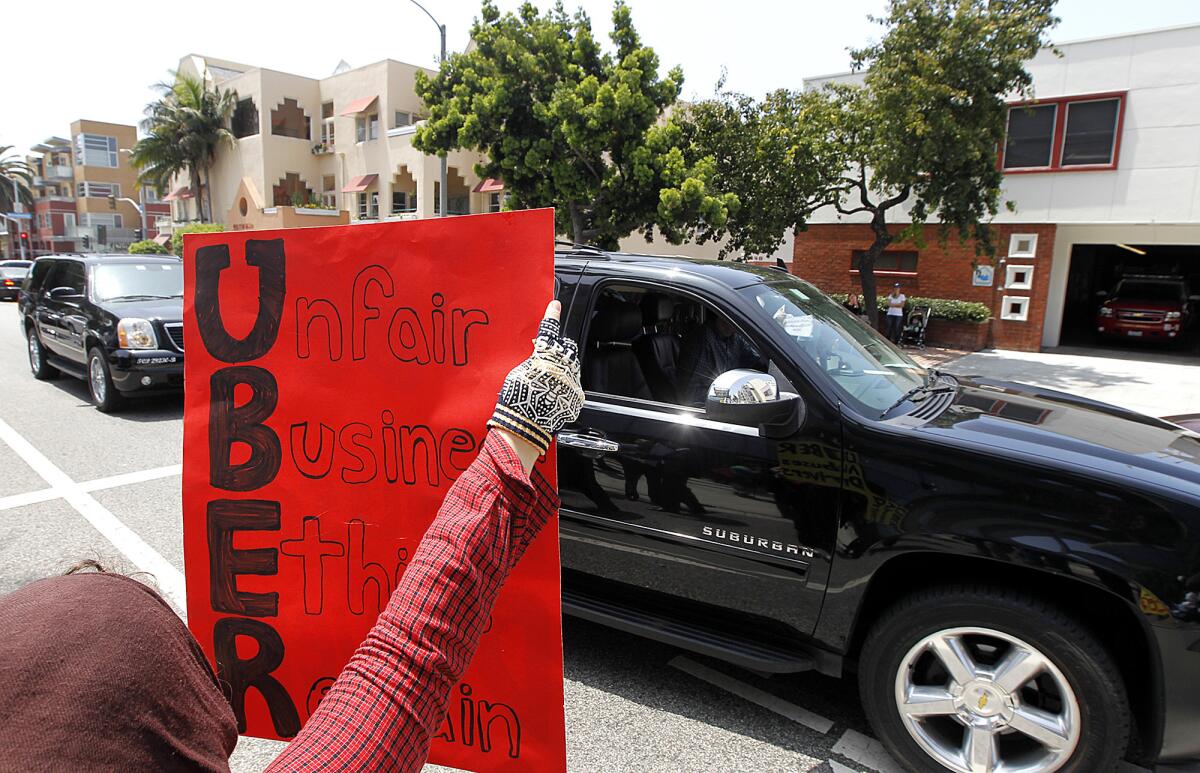Are we really turning into a nation of Uber drivers? Not yet.

Uber drivers protested the firm’s employment practices outside its Santa Monica offices last year.
- Share via
The latest article of faith in pop economics is that we’re becoming a nation of freelance workers. Going by many names -- the “1099 economy,” the “gig economy,” the “sharing economy” -- the phenomenon is also the topic of disagreement over whether it’s good or bad.
Its fans say it has given workers unprecedented control over their time, income, and destiny; its detractors that it has opened new avenues of exploitation of these same workers by technological middlemen. Think Uber, whose treatment of drivers recently came under the gimlet-eyed scrutiny of California labor regulators.
What seems to have gained wide acceptance is that this transformation has begun, and it’s inexorable. As TechCrunch declared earlier this month in an article headlined “In the Future, Employees Won’t Exist”: “Contract work is becoming the new normal.”
That may or may not be true in the future. But as Moody’s Analytics economist Adam Ozimek points out, it’s not at all true today. In fact, the trend is marginal at best.
“People are talking about a transformation of the labor force and how the nature of work has changed,” he says. “But the idea that a massive transformation is underway has been oversold. For most people, the nature of work has not changed.”
Ozimek outlined his findings in a post Monday on the Moody’s Analytics Dismal Scientist blog. The hard data from the Bureau of Labor Statistics, he observes, “suggest that if the end of employment-as-usual is coming, the change hasn’t started showing up yet.”
For example, although rhetoric about the “sharing economy” would imply that self-employment is at an all-time high, the percentage of workers reporting that they are unincorporated self-employed is falling and “lower than at any point in the last 70 years.”
As for the idea of workers “cobbling together a living via multiple part-time gigs”: also not happening. The share of multiple-job workers is at a 20-year low. Although voluntary part-time work is on the rise (unlike recession-driven forced part-time hours), full-time work is heading back to its historical normal level of about 84%.
Put it all together, Ozimek writes, and it indicates that “for now, the ‘gig economy’ and a ‘nation of freelancers’ remains a phenomenon on the margins of the labor market.”
So what’s driving all the talk about the transformation of work? Ozimek speculates that it’s partially “excitement about new technology.” The Internet and smartphone apps certainly have eliminated some obstacles to bringing providers and consumers of labor together, whether that’s drivers, housekeepers, or handymen. “That heralds a potential future, but it also makes people eager to jump the gun.”
But another factor may be that the talk is coming from self-promoting beneficiaries of this supposed new economy. Firms such as Uber have a vested interest in portraying themselves as job creators and liberators of workers from the shackles of employment, because their growth depends on avoiding the costs and responsibilities of being old-style employers.
In an interview Monday with Caroline Fairchild of LinkedIn, Uber’s chief strategist, former White House aide David Plouffe, asserted that Uber’s “independent contractor” model “allows people to drive for multiple platforms. If you start classifying people as employees, even if they are part time, they can’t drive for Uber and Lyft, they have to choose.”
That’s one way of looking at it. Another way is that standard employment would bring those people the stability in wages and working conditions that would make driving for multiple platforms unnecessary. It may be that people drive for both Uber and Lyft because they have to, not because they want to.
Other promoters of the notion of a freelanced, outsourced workforce include companies that hope to sell services to the buyers of such services as well as the providers. “Imagine a world where contingent work is as common as traditional employment,” urged Intuit, the maker of do-it-yourself tax and accounting software, in a 2010 forecast. The report projected that contingent workers in the U.S. “will exceed 40% of the workforce by 2020,” up from 25%-30% in 2010.
If that’s so, the trend had better pick up steam. In 2014, according to the BLS, voluntary part-timers, the unincorporated self-employed and multi-employer workers -- the three major categories making up the contingent workforce -- accounted for 24.6% of all workers.
More to the point, the percentage has been declining since at least 1994, the year the BLS started tracking all three categories, when it was about 28.9%. The ratio has ticked up modestly since 2012, but that’s a tiny tick on which to erect a big projection.
None of this means that the “gig economy” won’t develop as the future-spotters hope (or fear), only that the trend remains a lot murkier than you’d think. Ozimek, for one, believes that it’s not too early to prepare for the possibility so that the transformation, if it occurs, serves everybody fairly.
“There’s good reason for thinking about the kind of laws we should have and regulations we might need,” he says. “But it’s not accurate to say that it’s already here.”
Keep up to date with the Economy Hub. Follow @hiltzikm on Twitter, see our Facebook page, or email [email protected].







